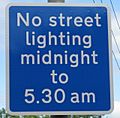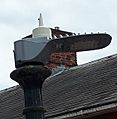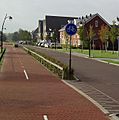Streetlight facts for kids
A streetlight is like a tall lamp post that lights up streets and paths at night. These lights help people see where they are going, making it safer to walk, bike, or drive after dark. They also help prevent accidents and make places feel more secure.
Streetlights come in different types and give off different colors of light. You might notice some streetlights glow with an orange light, while others shine with a blue or white light.
Contents
Types of Streetlights
Streetlights use different kinds of light bulbs to create their glow. The two main types you'll often see are mercury-vapor lamps and sodium-vapor lamps.
Mercury-Vapor Lamps
These lights usually give off a bluish-white light. They are an older type of streetlight, but they are known for lasting a long time. They work by passing electricity through mercury vapor, which creates the light.
Sodium-Vapor Lamps
These are newer and more energy-efficient streetlights. They typically produce a yellowish-orange light. There are two kinds:
- Low-pressure sodium lamps: These give a very strong orange glow. They are super efficient, meaning they use less electricity to produce a lot of light.
- High-pressure sodium lamps: These give a slightly whiter, more golden-orange light. They are also very efficient and are commonly used today.
Why Are Streetlights Important?
Streetlights play a big role in our daily lives, especially after the sun goes down.
Keeping People Safe
One of the most important jobs of streetlights is to keep people safe. When streets are well-lit, drivers can see pedestrians, cyclists, and other vehicles more clearly. This helps prevent crashes. For people walking or biking, good lighting means they can see obstacles, uneven ground, and feel safer from potential dangers.
Helping You See
Imagine trying to find your way around a dark street! Streetlights make it easy to see where you are going, read street signs, and find house numbers. They help us navigate our neighborhoods and cities at night.
Saving Energy with Smart Lights
Newer streetlights are often "smart." This means they can be controlled remotely by city workers. Some lights can dim or turn off when there's no one around, saving energy. Others might have sensors that adjust their brightness based on how much natural light there is, like on a cloudy day. This helps cities save electricity and reduce light pollution, which is when too much artificial light brightens the night sky.
Images for kids
-
William Murdoch's house in Redruth, UK, the first domestic house in the world to be lit by gas
-
Map of Tamworth, New South Wales, showing the position of leads and lights along the network of city streets in 1888
-
The distinctive monochromatic yellow glow from a low-pressure sodium lamp in the UK
-
Old-style street light with lamps near the Mönchbruch hunting lodge near Rüsselsheim am Main, Germany
-
Sign in Leeds, UK indicating part-night lighting, meant to save energy and reduce light pollution.
-
Decorative but functional lamps in the Plaza at sunset, Samaipata, Bolivia
-
High-mast lighting along Highway 401 in Ontario, Canada
-
Lights similar to street lights are used at train stations; these are at London King's Cross
-
A farola fernandina in Aranjuez
-
Street light in Ferdinand VII style near the Royal Palace of Aranjuez
-
Street light from the 1950s attached to a utility pole in New Jersey
See also
 In Spanish: Alumbrado público para niños
In Spanish: Alumbrado público para niños
























